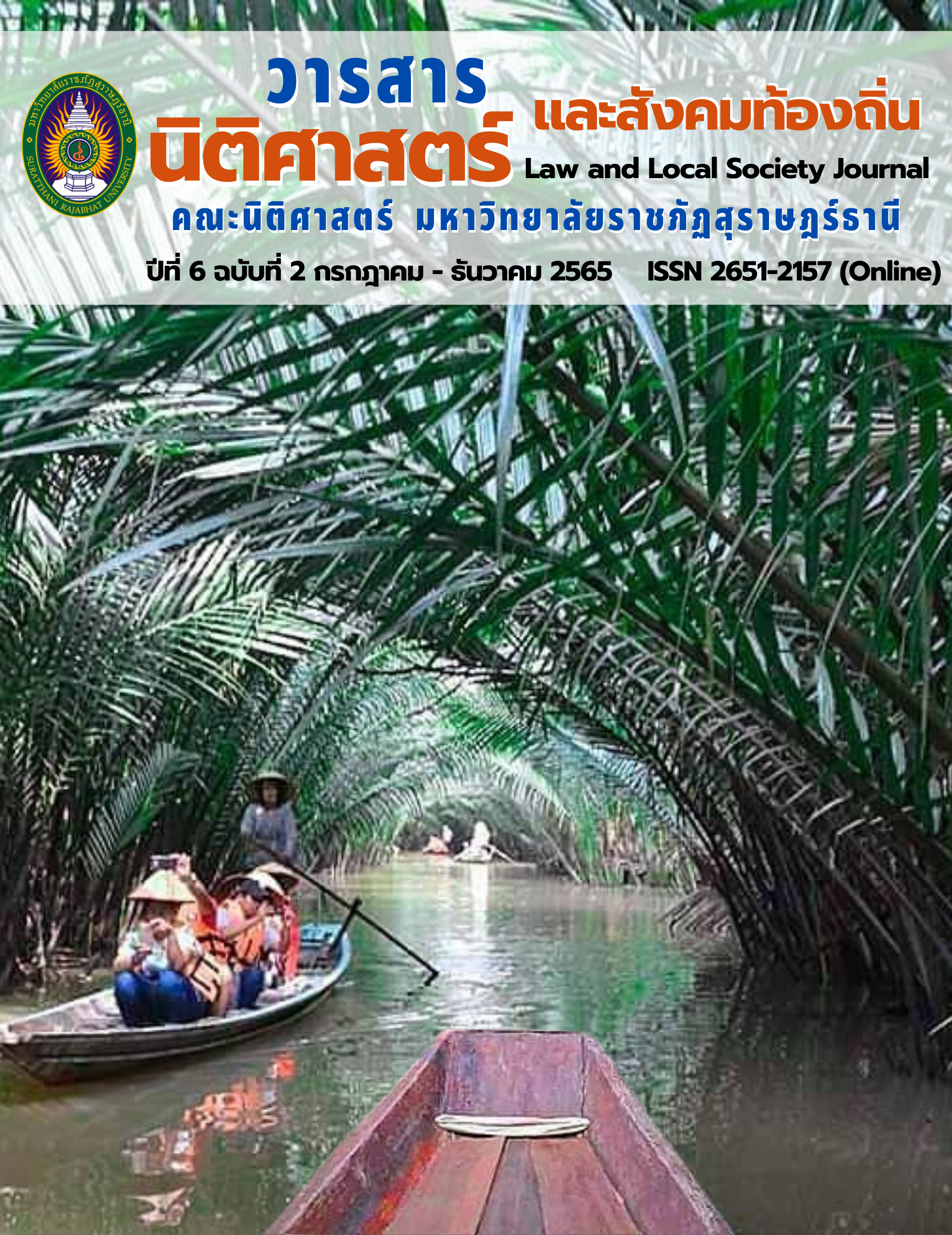การเข้าถึงและการแบ่งปันผลประโยชน์จากทรัพยากรพันธุกรรมพืชชนิดเดียวกันในประเทศที่มีพรมแดนติดกัน
คำสำคัญ:
ทรัพยากรพันธุกรรมพืชชนิดเดียวกัน, การเข้าถึงและการแบ่งปันผลประโยชน์, สิทธิอธิปไตยของรัฐ, การจัดการผลประโยชน์รูปแบบพหุภาคีบทคัดย่อ
งานวิจัยนี้เป็นการศึกษาปัญหาการเข้าถึงและการแบ่งปันผลประโยชน์จากทรัพยากรพันธุกรรมพืชชนิดเดียวกันในประเทศที่มีพรมแดนติดกัน โดยมีวัตถุประสงค์เพื่อศึกษาหลักการและแนวคิด รวมถึงกฎหมายที่ใช้บังคับกับกรณีดังกล่าวในระดับระหว่างประเทศและในระดับประเทศ ได้แก่ ไทย เวียดนาม ลาว กัมพูชา และมาเลเซีย เพื่อเสนอแนวทางแก้ไขปัญหาดังกล่าว
เมื่อทำการศึกษาพบว่า อนุสัญญาว่าด้วยความหลากหลายทางชีวภาพ พิธีสารนาโงยาว่าด้วยการเข้าถึงทรัพยากรพันธุกรรมและการแบ่งปันผลประโยชน์ที่เกิดขึ้นจากการใช้ประโยชน์ทรัพยากรพันธุกรรมอย่างเท่าเทียมและยุติธรรม และสนธิสัญญาระหว่างประเทศว่าด้วยทรัพยากรพันธุกรรมพืชเพื่ออาหารและการเกษตร ได้ยืนยันถึงหลักสิทธิอธิปไตยเหนือทรัพยากรพันธุกรรมพืชว่าประเทศใดต้องการใช้ประโยชน์ทรัพยากรพันธุกรรมพืชในดินแดนของประเทศหนึ่ง จะต้องขออนุญาตเข้าถึงและตกลงแบ่งปันผลประโยชน์ที่จะเกิดขึ้นกับประเทศเจ้าของดินแดน แต่กฎหมายที่ใช้บังคับอยู่ไม่ครอบคลุมไปถึงการแบ่งปันผลประโยชน์จากทรัพยากรพันธุกรรมพืชชนิดเดียวกันที่มีถิ่นที่อยู่ในหลายประเทศ ประเทศที่ไม่มีการเข้าถึงจึงไม่อาจได้รับการแบ่งปันผลประโยชน์
การศึกษาวิจัย ได้เสนอแนวทางแก้ไข 2 ขั้นตอน ดังนี้ ขั้นตอนที่หนึ่ง ทำความตกลงแบ่งปันผลประโยชน์ในระดับภูมิภาคระหว่างประเทศที่เกี่ยวข้องในรูปแบบทวิภาคีหรือไตรภาคี โดยคำนึงถึงสิทธิอธิปไตยของรัฐ กำหนดนิยามคำว่า “การใช้ประโยชน์ทรัพยากรพันธุกรรมพืชชนิดเดียวกัน” และ “ลำดับอนุกรมวิธานพืช” ในความตกลง และเปิดโอกาสให้มีการเจรจาตั้งกองทุนระดับภูมิภาค ขั้นตอนที่สอง กำหนดมาตรการความร่วมมือข้ามพรมแดนในพิธีสารนาโงยาให้ชัดเจน และใช้กลไกพหุภาคีระดับโลกเพื่อการแบ่งปันผลประโยชน์โดยสอดคล้องกับข้อ 10 ของพิธีสารนาโงยา
เอกสารอ้างอิง
Bonn Guidelines on Access to Genetic Resources and Fair and Equitable Sharing of the Benefits Arising out of their Utilization
Boonchub Boonthawee. “Seed Procurement.” https://www.dnp.go.th/ research/Knowledge/seed.htm (Retrieved on 1 November 2022)
Chakkrit Kuanpot. GMO, Biotechnology War. Bangkok: Nation Multimedia Group, 2002.
Chakkrit Kuanpot. Patent Law, Concept and Analysis. 3rd Edition. Bangkok: Nititham, 2013.
Chanokphorn Prompinchompoo and Chantrathip Sukhum. Handbook of Legal Reforms for Social Development in terms of Human Rights (Checklists) on Intellectual Property Law and Problems of Drug and Plant Protection. Bangkok: Office of the Law Reform Commission, 2014.
Charoen Khumphiraphap. “Sovereignty and Sovereign Rights over Plant Genetic Resource Bases.” http://www.measwatch.org. (Retrieved on 9 May 2018).
Chelsea B., Elizabeth P., Stephanie R.. “The Common Concern of Humankind: A Potential Framework for a New International Legally Binding Instrument on the Conservation and Sustainable Use of Marine Biological Diversity in the High Seas.” https://www.un.org/
depts/los/biodiversity/prepcom_files/BowlingPiersonandRatte_Common_Concern.pdf (accessed November, 2021).
Chitraphorn Thawatphan. Principles of Plant Taxonomy. Bangkok: Kasetsart University, 2005.
Convention on Biological Diversity 1992.
European Union ABS Regulation No.511/2014
International Treaty on Plant Genetic Resources for Food and Agriculture 2001.
John Locke. “Two Treatises of Government.” In The Project Gutenberg eBook of Two Treatises of Government, 25. 2005 https://www. gutenberg.org/files/7370/old/trgov10h.htm accessed August 14, 2020).
Marco C., Didier B., Dominique D., Selim L., Michel T. and Henri H.. Quinoa and the exchange of genetic resources: improving the regulation systems.” Chapter 1.6. (State of the Art Report of Quinoa in the World in 2013). FAO & CIRAD: Rome, 2015, 98 https://www.fao.org/3/i4042e/i4042e.pdf (accessed December, 2020)
Melissa L. Sturges. “Who Should Hold Property Rights to the Human Gnome? An Application of the Common Heritage of Mankind.” American University International Law Review 13, 1 (1997): 246.
Mohamad Bin Osman and A. H. Zakri. “Malaysia’s Approach to Access and Benefit Sharing.” (Presently with the School of Environmental and Natural Resource Sciences, Faculty of Science and Technology, University Kebangsaan Malaysia, n.d.)
NGUYEN Dang Thu Cuc and TRAN Thi Huong Trang. “Vietnam’s Legislation on Access to Genetic Resources and Benefit Sharing (ABS): Achievements, Remained Weakness and Solutions.” Journal of Korean Law 18, 1 (2018): 139-156.
Onrampha Rattanamanee. “Problems of Using the Convention on Biological Diversity (CBD) and The Agreement on Trade-Related Aspects of Intellectual Property Rights (TRIPS) to Protect Biological Resources in Developing Countries.” Master's Degree Thesis on Law, Faculty of Law Thammasat University, 2008.
Ratchaneekorn Lapvanichcha Phromsak. “New Plant Protection System: A Comparative Legal Perspective.” Journal of Law 47, Vol.3 (2018): 685-686.
Somchai Rattanachuesakul. “The Impact of International Agreements on Intellectual Property on Thailand’s Plant Genetic Resource Base.” In Towards Resource Base Reform, Edited by Chakkrit Kuanpot, and Banthoon Setthasirot, 687. Bangkok: Resource Base Policy Strategy Project National Human Rights Commission 2003.
Thanit Changthaworn. “Minutes of Meeting on Access and Benefit Sharing from Biological Resources and Related Local Wisdom” (Perspectives and Actions on Access and Benefit Sharing in ASEAN Member States). National Center for Genetic Engineering and Biotechnology, n.p.
UNEP/CBD/ABS/A10/EM/2016/1/4
Vietnam Biodiversity Law 2008.
ดาวน์โหลด
เผยแพร่แล้ว
รูปแบบการอ้างอิง
ฉบับ
ประเภทบทความ
สัญญาอนุญาต
ลิขสิทธิ์ (c) 2022 วารสารนิติศาสตร์และสังคมท้องถิ่น

อนุญาตภายใต้เงื่อนไข Creative Commons Attribution-NonCommercial-NoDerivatives 4.0 International License.
บทความที่ได้รับการตีพิมพ์ในวารสารนิติศาสตร์และสังคมท้องถิ่น คณะนิติศาสตร์ มหาวิทยาลัยราชภัฏสุราษฎร์ธานี ถือเป็นลิขสิทธิ์ของวารสาร ทั้งนี้ ข้อมูล เนื้อหา และข้อคิดเห็นที่ปรากฏในบทความเป็นความรับผิดชอบของผู้เขียนแต่เพียงผู้เดียว กองบรรณาธิการไม่มีความจำเป็นต้องเห็นด้วยหรือร่วมรับผิดชอบใด ๆ
เนื้อหา ข้อมูล รูปภาพ และองค์ประกอบอื่น ๆ ที่ได้รับการตีพิมพ์ในวารสารฯ อยู่ภายใต้ลิขสิทธิ์ของวารสารนิติศาสตร์และสังคมท้องถิ่น การนำไปเผยแพร่ ดัดแปลง หรือใช้ประโยชน์ในลักษณะใด ๆ ไม่ว่าเป็นบางส่วนหรือทั้งหมด ต้องได้รับอนุญาตเป็นลายลักษณ์อักษรจากวารสารก่อน


